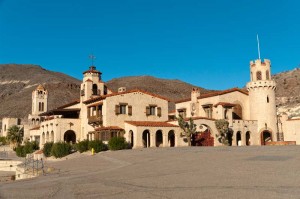This morning we drove about 100 km north of our campsite here in Furnace Creek to Scotty’s Castle. This is a large personal retreat complex built by wealthy financiers Albert and Bessie Johnson of Chicago, together with their “partner in crime” Walter “Scotty” Scott, between about 1922 and 1931. Scotty was really a con man, telling everyone that the he was building a castle over his gold mine. However, there never was a mine and the castle wasn’t his either.
For the first hour of the tour we were guided by a young lady in 1939 period costume, who took us throughout the upper portion of the castle. We saw several of the rooms outfitted with the Johnson’s original furniture. The furniture was beautiful, but hard to see as it was kept very dark in the house. However it shows up well in the pictures we took. There was an incredible amount of ceramic tile throughout the house. Much of the tile was custom designed for them as it had their logo on a lot of the tiles. The dishes were similarly marked with their initials. There was a great deal of silverware and other fancy furnishings throughout the house.
The house and building complex must have cost a very large amount of money, for it incorporated all the latest technology of the day, such as solar heated water, refrigerator, and their own hydro-electrical generating plant based on a Pelton water wheel. In the second part of the tour we got to see under the castle, and got a good view of how the technology was incorporated into a tunnel system connecting the buildings. In 1931 construction was abandoned, we suspect because the Johnson’s had lost a great deal of money in the depression; however the circulated story is that they were in a conflict with the federal government over their land boundary. Supposedly they had built the house on land that was mis-surveyed, and their true parcel was over two kilometers away. This land claim was not settled until 1937, and construction that had stopped was never restarted.
Because the construction was abandoned, one of the most obvious uncompleted features is a huge swimming pool. It would have had two pools – one a shallower swimming pool at least 20 metres long, and another deep diving tank, about the same length and at least three or four metres deep. The walls of the pool are in place, but the floor was never poured. On the basement tour we saw stacks of tiles that were to have been used for the walls of the pool, but never installed.
After this morning at the castle showing how these wealthy people interacted with their environment in the 1920’s, we got back to our visit to the natural environment of Death Valley. We drove to Ubahebe crater, which is a steam and magma explosion crater, believed to be only about 2000 years old. Then we drove in to the end of Titus Canyon. It looks like it would be an interesting drive as the narrow one-way single lane gravel road winds around for thirty kilometers through the rocks of the canyon. We walked up the road, but only for about 500 metres. Finally we finished the day with a short interpretive hike at Salt Creek. It is the most water we have seen in Death Valley, a small stream about a meter wide and maybe 10 cm deep – and very salty judging from the salt crystals in the mud of the stream. The stream flows out into the salt flats north of Furnace Creek, to the area where they mined borax in the late 1890’s.


